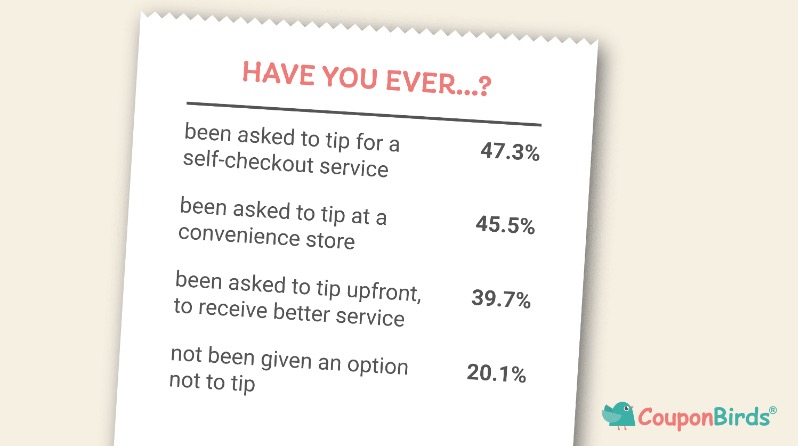Tipping culture is out of control, customers say — and service industry workers agree: survey
Contact The Author
Tip culture has reached a tipping point.
A new survey of American consumers and service workers found that 76.1% believe tipping has “gone too far” — but it’s not only diners who dread it as more than half (51%) of service workers agree, saying they would prefer to be paid a living wage and receive no tips.
Tipping is an expectation in the American service industry, and how many workers’ salaries are supplemented. Yet as the cost of living increases across the country, so, too, do the demands of businesses and workers who rely on cash gifts to get by — a trend some are calling “tipflation.”
CouponBirds surveyed 1,199 Americans of different ages to find out how, why and where they tip. They also did a separate survey of 629 American service industry workers to get their side of the situation.
According to the survey, six in 10 service workers rely on tips for more than 30% of their income. 38.5% of tipped employees are paid between $7.25 and $10 per hour before tips, and 32% are paid at least $10 an hour. About two in ten (19.5%) are paid as little as $2.13 per hour.
The average amount a service industry worker receives in tips per week is $290 — and, excluding the 11.9% of people who make more from tips than their wage, the average service industry worker made nearly half (49.7%) of their earnings in tips, the survey found.
Meanwhile, anti-tipping trends appear to be taking hold as 73.7% of service industry workers noticed that customers are tipping less than they used to: 42% of service workers reported that they are only “sometimes” tipped and less than three in 10 (27.2%) said they are always tipped.
The most affected tip-based industry is taxi and transport servers, where 87.8% of workers noticed a drop in tipping.
The national living wage is estimated by the Massachusetts Institute of Technology to be $25, meaning that the majority of survey respondents are attempting to get by on much less.
When asked, 51% said they would prefer to make a living wage of $25 per hour without any tips, 39.3% preferred optional tipping and 9.7% are happy with the status quo.
Almost all service industry workers (99.9%) polled were in support of increasing the minimum wage compared to the population average of 84.1%. Slightly less than half (47.8%) wanted the service charge to be made mandatory, compared to the study average of 38.9%.
A service industry worker in America — including restaurant servers, hairdressers and cab drivers — typically have an annual salary between $31,896 and $67,836, according to Paylab. Restaurant servers in particular have a low salary, raking in $28,176 per year, which is $541 per week or $13.55 an hour, according to ZipRecruiter.
The survey also discovered that half of tipped workers “substantially” underreport the amount they truly earn in tips. Tipped employees legally have to report what they earn, gratuity included, which doesn’t include service charges and involves keeping a daily record.
With mistrust of employers and low salaries, perhaps it’s not shocking that 87.8% underreport the amount of tips they receive, and 51.2% admit they do so substantially.
Part of the mistrust in the service industry has to do with wage theft. Of those polled, 57.4% said their management “definitely or probably” skimmed from tips, 30.2% thought they might and 12.4% weren’t sure or didn’t believe so.
88.8% of restaurant servers admitted that they kept the tips directly given to them, with 35.9% sharing that they always do this. A majority (83.3%) said they’ve pocketed a $100+ tip that was given to them directly.
Some shadier issues find their way into tipping culture discourse, including an argument that tipping culture promotes sexism, racism and exploitation — and there’s research that backs up these concerns.
The “most unanimous response” to the survey was to the question that asked “are more attractive servers tipped more,” with a resounding 90.7% of respondents saying yes. Female servers were almost twice as likely to be tipped above $100 in one go compared to men (16.01% versus 9.14%, respectively).
A survey conducted in June 2023 revealed that two-thirds of Americans hold a negative view of tipping, and 1 in 3 Americans think tipping culture is out of control.
For Gen Z in particular, only 24% always tip hairdressers, hairstylists or barbers, according to the survey, compared with 40% of millennials and 67% of Gen Xers. They are also less likely than baby boomers to tip when getting food delivered (31% compared to 62%) or using a taxi or ride-share service (22% versus 56%).
At the same time as some workers see a decline in tipping, the expectation to tip has also expanded.
Despite requiring zero interaction between customers and employees, self-checkout machines at venues like coffee shops, bakeries, airports and sports stadiums are being programmed with the option to leave the typical 20% tip.
Business owners believe that the prompt for a tip can boost staff pay and increase gratuities, according to a May 2023 report from the Wall Street Journal.
The self-checkout gratuity option is an example of “tip creep” — a phenomenon that prompts customers to leave higher tips in transactional situations.
Self-tipping is viewed by many customers as a way to guilt-trip the person into tipping on something when they typically wouldn’t.
However, experts say that tips at a self-checkout machine might never even get to an actual employee, since protections for tipped workers in the federal Fair Labor Standards Act don’t extend to machines, according to the Journal.















